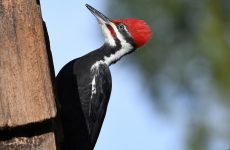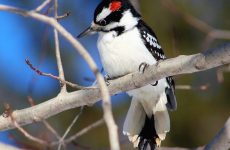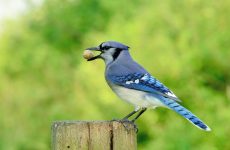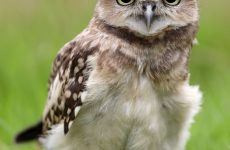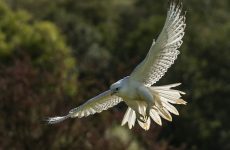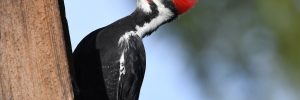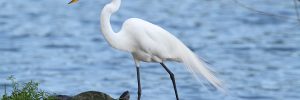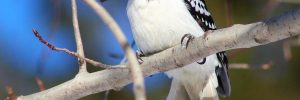
Have you wondered what those birds are that are visiting your backyard in Alberta?
Well, this guide will help you to find out how to identify these birds by sight and sound and what time of year you can spot them in Alberta. Also, get a free ID chart to print with the most common backyard birds in Alberta.
American Robins and Red-winged Blackbirds are more common birds in summer in Alberta, and Black-capped Chickadees and Downy Woodpeckers are more birds common in winter in Alberta. More information about this can be found at the end of the article.
Backyard birds in Alberta all year: Black-capped Chickadee, Black-billed Magpie, Downy Woodpecker, House Sparrow, Red-breasted Nuthatch, White-breasted Nuthatch, Northern Flicker, House Finch, Rock Pigeon, Hairy Woodpecker, European Starling
Backyard birds in Alberta in summer: American Robin, American Crow, Red-winged Blackbird, Yellow Warbler, Tree Swallow, Clay-colored Sparrow, Cedar Waxwing, House Wren, Dark-eyed Junco, Yellow-rumped Warbler, Chipping Sparrow, Savannah Sparrow, Brown-headed Cowbird, American Goldfinch, Song Sparrow, White-throated Sparrow, Pine Siskin, Ruby-crowned Kinglet
Backyard birds in Alberta in winter: Blue Jay
Backyard birds in Alberta during migration: White-crowned Sparrow
These are the most common backyard birds in Alberta that may visit your lawn or feeders. They are the birds that appear most frequently on state checklists submitted by bird watchers on ebird.
This article gives you identification information and photos to help you identify and attract more of the common backyard birds that you can spot in Alberta.
Free Printable Backyard Birds Worksheet for Alberta
These free bird identification worksheets have all the common backyard birds in Alberta at different times of the year. So when you want to do some backyard birding, these handy guides have pictures and space to either tick off the types of birds you have seen or keep a tally of the total number of birds.



Top 31 Backyard Birds In Alberta
1. Black-capped Chickadee
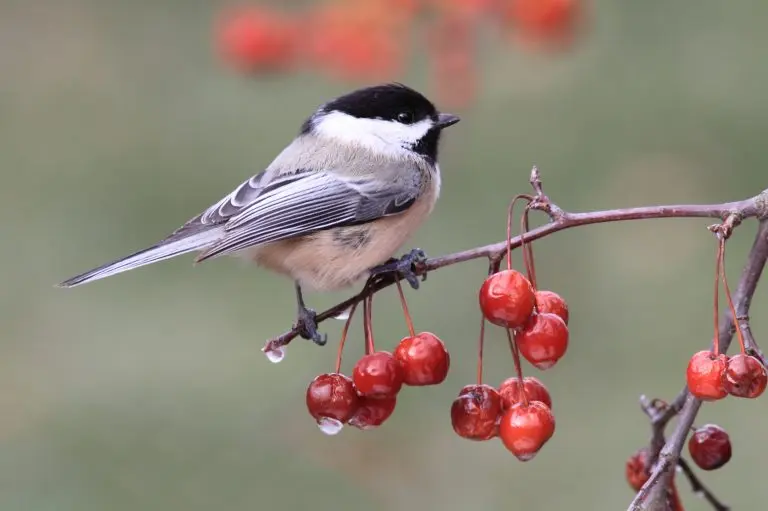
Black-capped Chickadees are residents of Alberta all year. Although they occur in more checklists in winter, this is due to the lack of other birds in winter. They do not migrate and occur in 32% of summer checklists and 63% of winter checklists submitted by bird watchers for the province.
The Black-capped Chickadee is a cute bird with a big round head and tiny body. These birds will happily feed at backyard feeders and investigate everything, including you!
They have black caps and beaks, white cheeks, and are gray on the back, wings, and tail.
- Poecile atricapillus
- Length: 4.7-5.9 in (12-15 cm)
- Weight: 0.3-0.5 oz (9-14 g)
- Wingspan: 6.3-8.3 in (16-21 cm)
Black-capped Chickadees do not migrate and can be spotted in the northern half of the US and Canada.
You can find them in forests, open woods, and parks. Black-capped Chickadees eat seeds, berries and insects, spiders, and suet.
Black-capped Chickadee Call/Song:
Attract Black-capped Chickadees to your backyard with suet, sunflower seeds, and peanuts or peanut butter. They will even feed from your hand and are often one of the first birds to discover new feeders. They will also use nest boxes, especially if you fill them with wood shavings.
2. American Robin
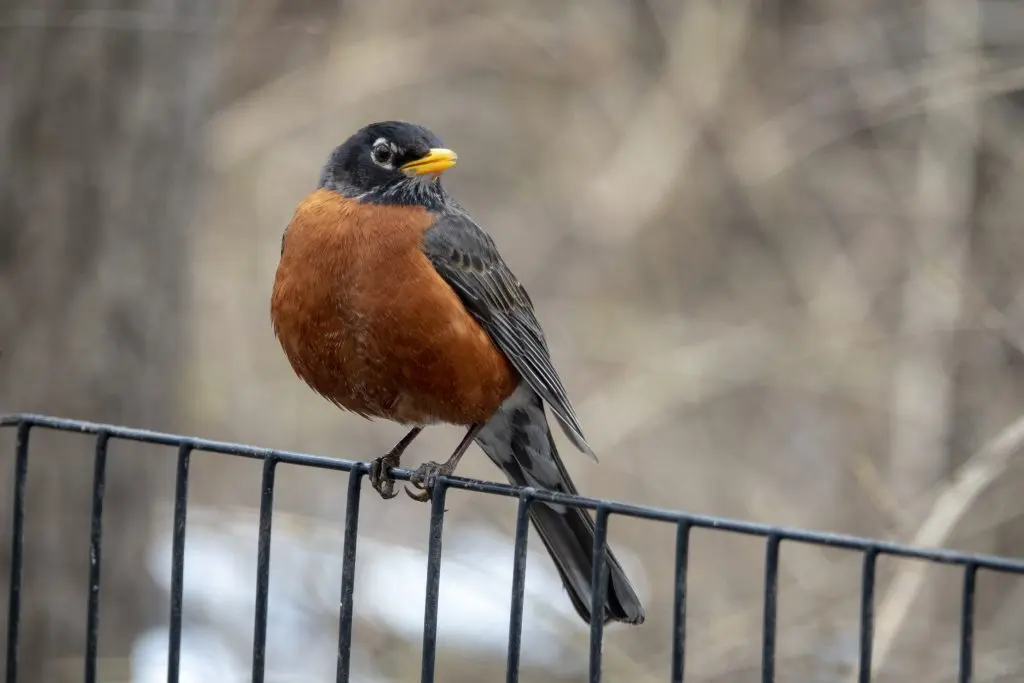
American Robins spend the breeding season in Alberta and occur in 54% of summer checklists. They are mainly spotted from April to October, but some remain in the province all year and appear in 2% of winter checklists.
American Robins are a common sight on lawns eating earthworms. They have black heads and backs with red or orange breasts. They tend to roost in trees in winter, so you are more likely to see them in your backyard from spring.
- Turdus migratorius
- Length: 7.9-11.0 in (20-28 cm)
- Weight: 2.7-3.0 oz (77-85 g)
- Wingspan: 12.2-15.8 in (31-40 cm)
American Robins are residents in the lower 48 and the coast of Western Canada and Alaska. Those that breed in Canada and inland Alaska move south for the winter.
American Robins can be found in many habitats, from woodlands, forests, and mountains to fields, parks, and lawns. They eat earthworms, insects, snails, and fruit.
American Robin Song:
American Robin Call:
Attract American Robins to your backyard with sunflower seeds, suet and peanut hearts, fruit, and mealworms. Platform feeders are best or food scattered on the ground. Also, try planting some native plants that produce berries, such as juniper, sumac, hawthorn, and dogwood.
3. American Crow
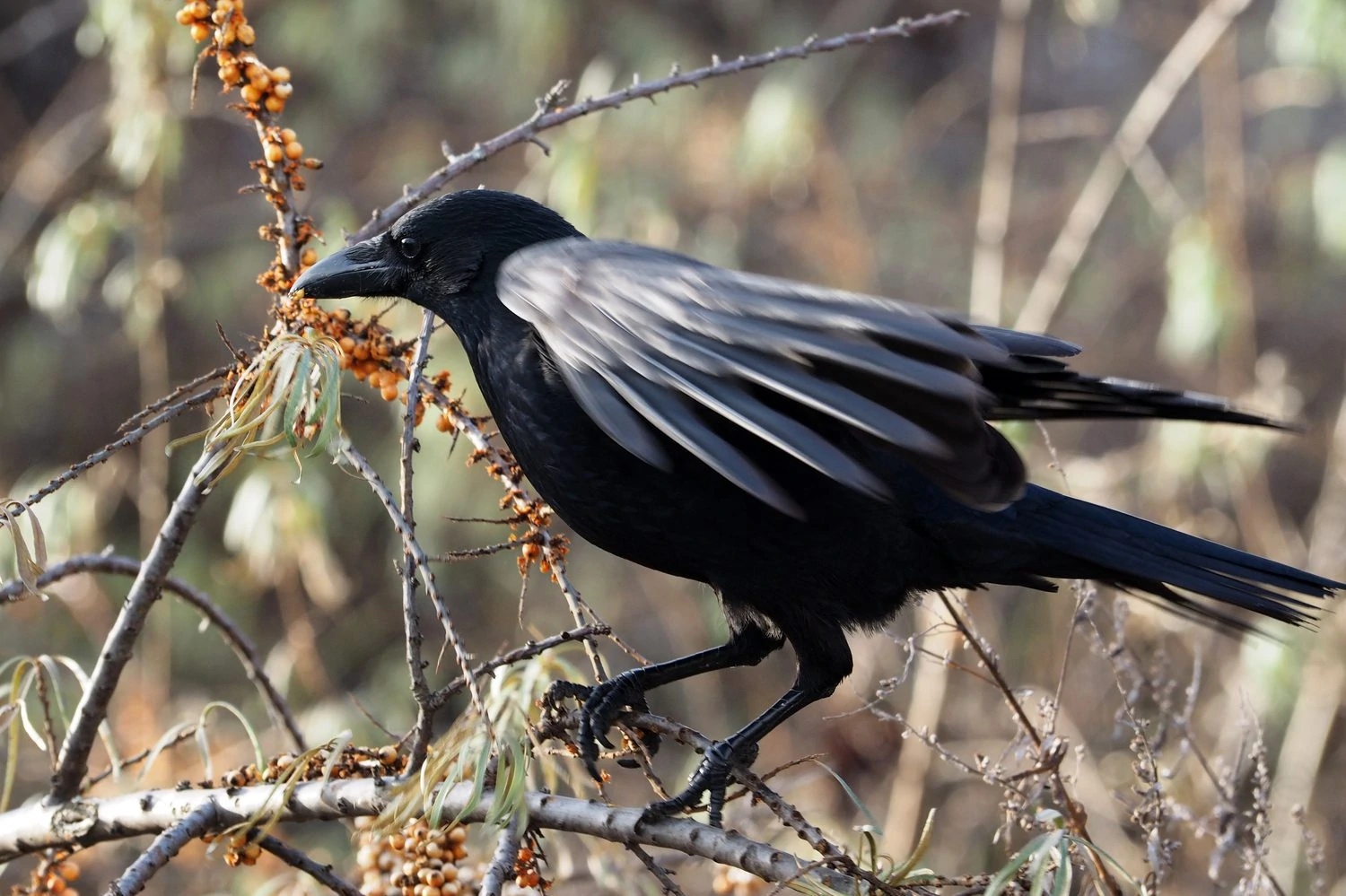
American Crows spend the breeding season in Alberta, but their numbers increase during migration from April to May and August to September. They appear in 40% of summer checklists and up to 54% of checklists during migration.
American crows are large all-black birds that make a hoarse, cawing sound.
- Corvus brachyrhynchos
- Length: 15.8-20.9 in (40-53 cm)
- Weight: 11.2-21.9 oz (316-620 g)
- Wingspan: 33.5-39.4 in (85-100 cm)
American Crows are residents all year in most of the lower 48 and the Pacific Coast in Canada and Alaska. Those that breed in Canada and the northern Midwest migrate south for winter.
They are common birds found in most habitats, including treetops, woods, fields, beaches, or towns.
They eat most things and usually feed on the ground, eating earthworms, insects, seeds, and fruit. They also eat fish, young turtles, mussels, and clams and will even eat eggs and nestlings of many species of birds.
In winter, American Crows gather in large numbers of up to two million crows to sleep in noisy communal roosts.
American Crow Call:
Attract American Crows to your backyard by scattering peanuts, but they can become a nuisance as they are attracted by garbage or pet food if left out.
4. Blue Jay
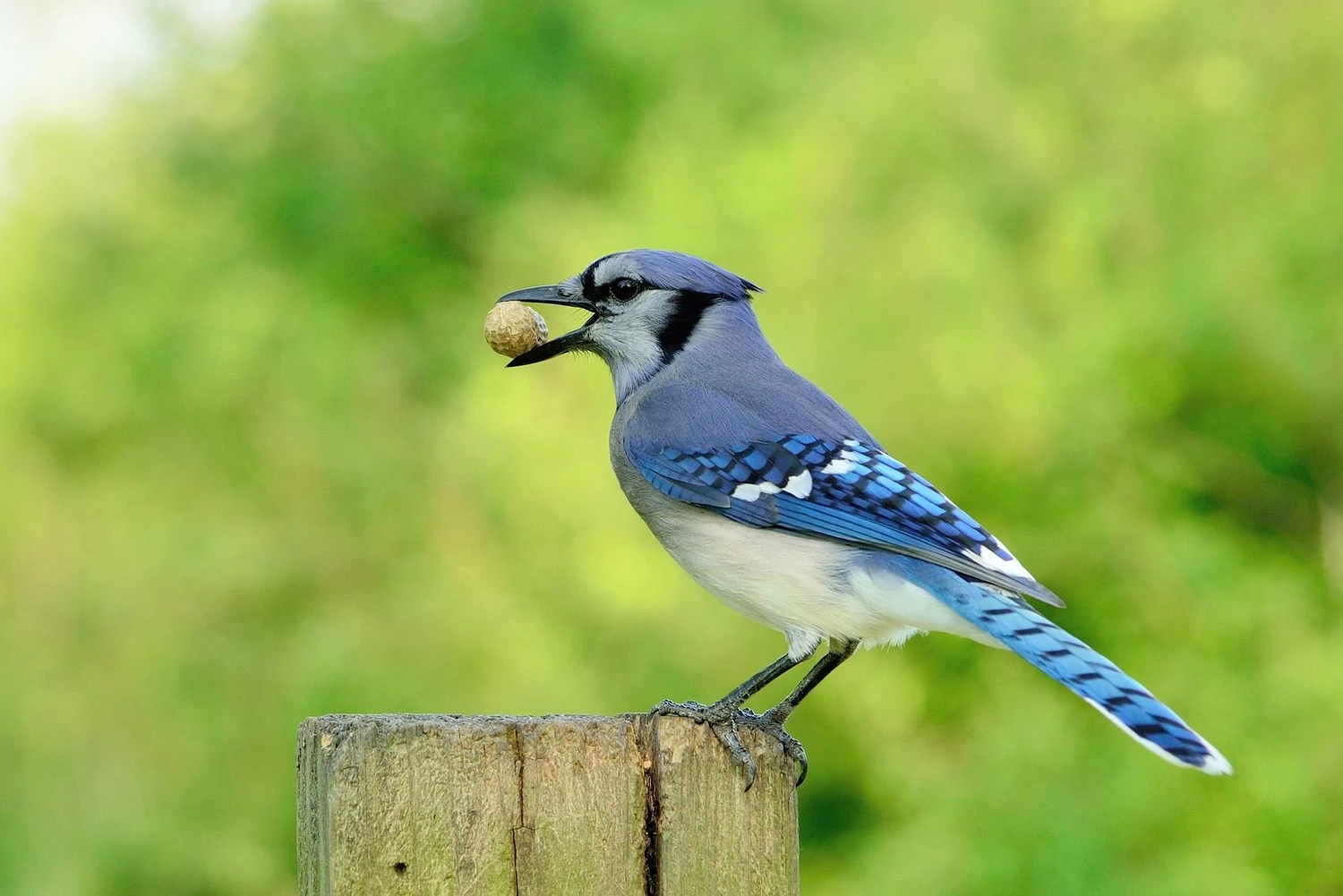
Blue Jays are spotted more often during winter in Alberta, but they remain in the province all year. They are recorded in 9% of summer checklists and 27% of winter checklists.
Blue Jays are common large songbirds with a blue upright crest, blue and black backs, and white undersides.
- Cyanocitta cristata
- Length: 9.8-11.8 in (25-30 cm)
- Weight: 2.5-3.5 oz (70-100 g)
- Wingspan: 13.4-16.9 in (34-43 cm)
Blue Jays live in eastern US states and Southern Canada all year. Some birds will migrate west for winter but not very frequently.
They are noisy birds that travel in family groups eating acorns when available. They can be found in forests, mainly near oak, as they eat acorns. They can also be found in backyards near feeders. As well as acorns, they eat insects, nuts and seeds, and grain. They may also take eggs from nests or take nestlings.
Blue Jay Call:
Blue Jays are large birds and prefer to fly in, grab a peanut or sunflower seed and take it away to feed. They prefer platform or tray feeders to make it easy to make a quick exit.
Attract Blue Jays to your backyard with peanuts, sunflower seeds, and suet. They prefer these on open tray feeders or hopper feeders on a post. They will also enjoy a birdbath.
5. Black-billed Magpie
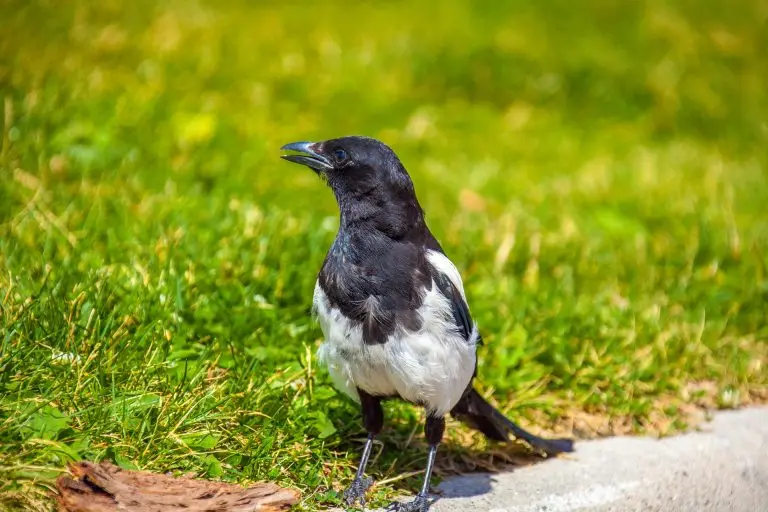
Black-billed Magpies are spotted more in Alberta during winter, from October to March, but they are also residents of the province all year. They appear in 37% of summer checklists and 66% of winter checklists. Although they occur in more checklists in winter, this is probably due to the lack of other birds in winter in the province.
Black-billed Magpies, usually just called Magpies, are black and white birds that are noisy. They have long tails and blue-green iridescent flashes in the wing and tail. Males are up to 25% heavier than females.
- Pica hudsonia
- Length: 17.7-23.6 in (45-60 cm)
- Weight: 5.1-7.4 oz (145-210 g)
- Wingspan: 22.1-24.0 in (56-61 cm)
Black-billed Magpies live in northwestern US states and western Canada, and the coast of Alaska. They do not migrate.
You can find them walking on the ground in meadows and grasslands or other open areas feeding on fruit and grain, beetles, and grasshoppers. They have also been known to kill small mammals such as squirrels and voles and raid bird nests for eggs or nestlings and even carrion.
Black-billed Magpie sounds: A series of harsh calls and also a scream.
You can attract Black-billed Magpies to your backyard with platform and suet feeders with black oil sunflower seeds, peanuts, fruit, suet, millet, and milo.
6. Downy Woodpecker
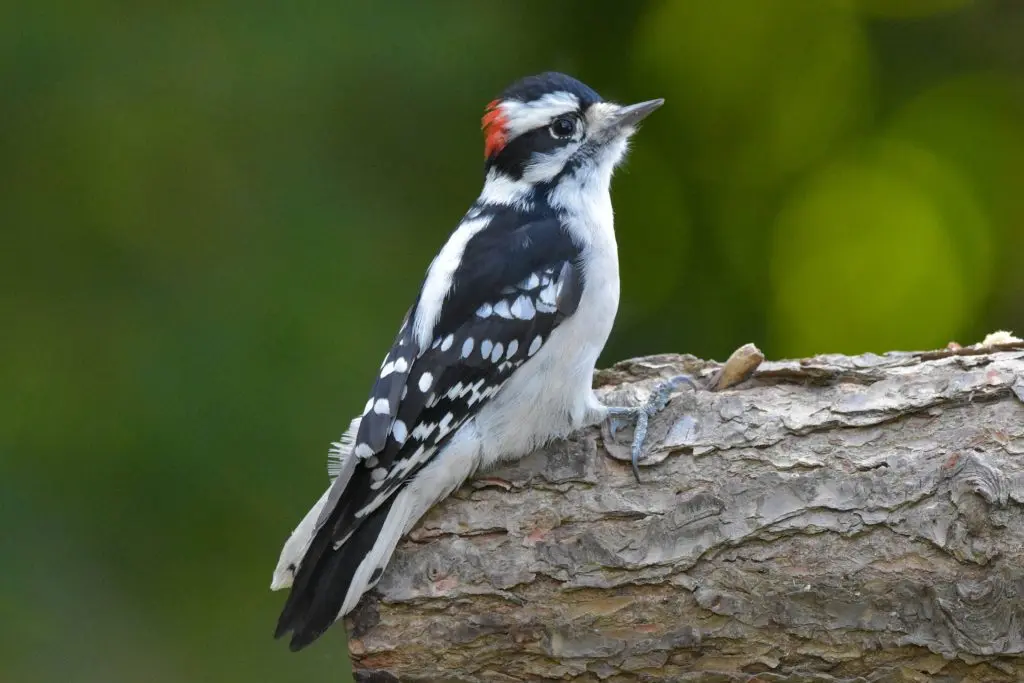
Downy Woodpeckers can be found all year in Alberta and do not migrate. They are recorded more from November to March, but this is probably due to the lack of other birds in winter here. They appear in 13% of summer checklists and 37% of winter checklists.
Downy Woodpeckers are small birds that are common at backyard feeders. They are often mixed in with other birds, such as chickadees and nuthatches.
They have black and white coloring with a red patch at the back of their heads. They look similar to the Hairy Woodpecker but smaller.
- Dryobates pubescens
- Length: 5.5-6.7 in (14-17 cm)
- Weight: 0.7-1.0 oz (21-28 g)
- Wingspan: 9.8-11.8 in (25-30 cm)
Downy Woodpeckers do not migrate and can be spotted in most states and provinces, except the north of Canada.
You can find Downy woodpeckers in woodlots, along streams, city parks, and backyards, and they eat mainly insects and beetle larvae but also berries, acorns, and grains.
Downy Woodpecker Call:
Attract Downy Woodpeckers to your backyard with their favorite treat of suet, but they will also eat black oil sunflower seeds, millet, and peanuts on platform feeders.
Some woodpeckers are more easily recognized than others, but with this guide, you can identify all the woodpeckers in Alberta.
7. House Sparrow
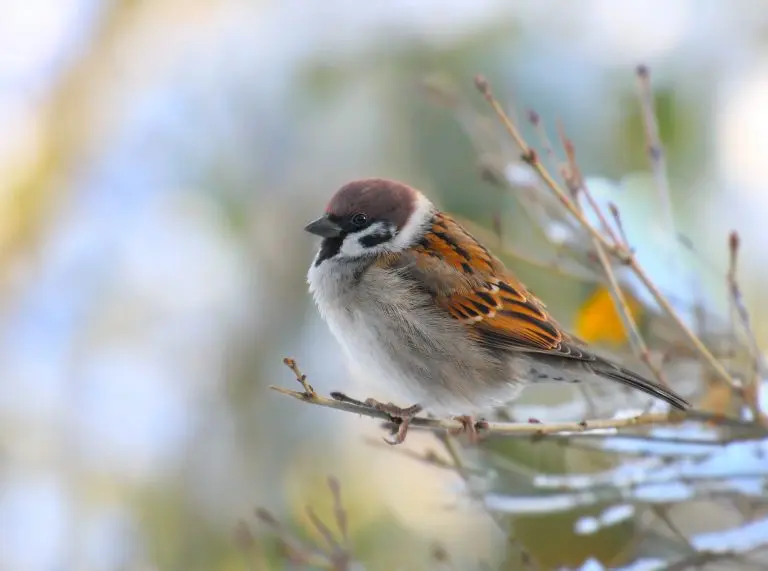
House Sparrows are an introduced species in Alberta that can be spotted here all year. They do not migrate and occur in 21% of summer checklists and 34% of winter checklists submitted by the bird watchers for the province.
The House Sparrow is another introduced species that has done very well and is now one of the most common birds. They have gray and brown heads and white cheeks. Their backs are black and brown, and their bellies are gray.
- Passer domesticus
- Length: 5.9-6.7 in (15-17 cm)
- Weight: 0.9-1.1 oz (27-30 g)
- Wingspan: 7.5-9.8 in (19-25 cm)
House Sparrows live in the US and Southern Canada all year.
You can find them near houses and buildings, and they can be pretty tame, and they may even eat out of your hand.
House Sparrows eat mostly grain and seed as well as discarded food. They can be considered a pest because they are non-native, but they are found in backyards even if you do not feed them.
House Sparrow Song:
Attract House Sparrows to your backyard feeders with most kinds of birdseed, including millet, corn, and sunflower seeds.
Sparrows are known as LBJs (Little brown jobs) but if you want to know more, check out this guide to sparrows in Alberta.
8. Red-winged Blackbird
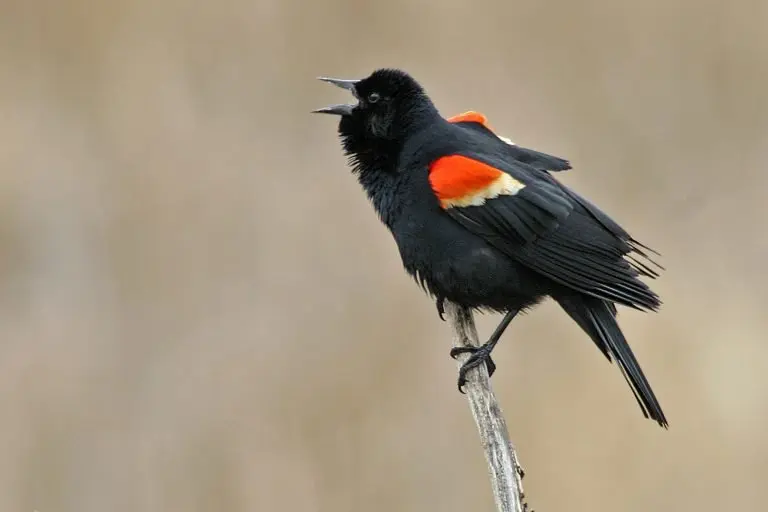
Red-winged blackbirds are frequently spotted in Alberta during summer. They spend the breeding season here and appear in 46% of checklists at this time. While many migrate south for the winter, a few remain in the province all year.
Red-winged blackbirds are very common and easy to identify with the all-black coloring except for the reddish-orange wing patches. Females are rather dull in comparison with streaky brown color.
- Agelaius phoeniceus
- Length: 6.7-9.1 in (17-23 cm)
- Weight: 1.1-2.7 oz (32-77 g)
- Wingspan: 12.2-15.8 in (31-40 cm)
Red-winged Blackbirds remain all year in the lower 48 and the Pacific Coast of British Columbia. Those that breed in Canada and some northern US states migrate south for the winter.
They can often be spotted sitting on telephone wires, and the males will fiercely defend their territories in the breeding season, even attacking people that get too close to their nests. In winter, they roost in large numbers into the millions.
Red-winged Blackbird Song:
Red-winged Blackbird Calls:
Attract Red-winged blackbirds to your backyard with mixed grain and seeds spread on the ground. They will also feed from large tube feeders or platform feeders.
Blackbirds are a vast family of birds that have numerous family members, and why don’t you get to know all the blackbirds in Alberta?
9. Red-breasted Nuthatch
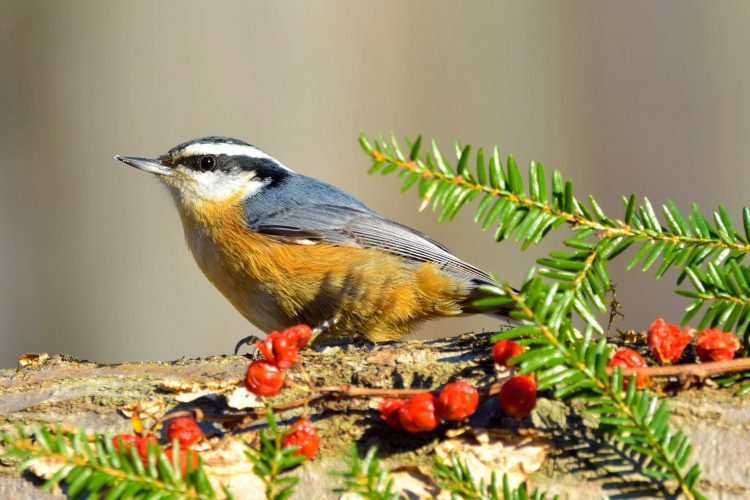
Red-breasted Nuthatches spend the breeding season in northern Alberta, but they are found in the south of the province all year. They are recorded in 14% of summer checklists and 25% of winter checklists.
Red-breasted Nuthatches are blue-gray birds with black and white stripes on their heads and a rusty underside.
- Sitta canadensis
- Length: 4.3 in (11 cm)
- Weight: 0.3-0.5 oz (8-13 g)
- Wingspan: 7.1-7.9 in (18-20 cm)
Red-breasted Nuthatches remain all year in northeastern and western states, Alaska and Canada but may move south in winter if cone crops are poor.
You can find Red-breasted Nuthatches in coniferous woods foraging for cones, and they also visit backyard feeders.
Red-breasted Nuthatch Call:
Attract Red-breasted Nuthatches to your backyard with black oil sunflower seeds, suet feeders, peanuts, and mealworms.
10. White-breasted Nuthatch
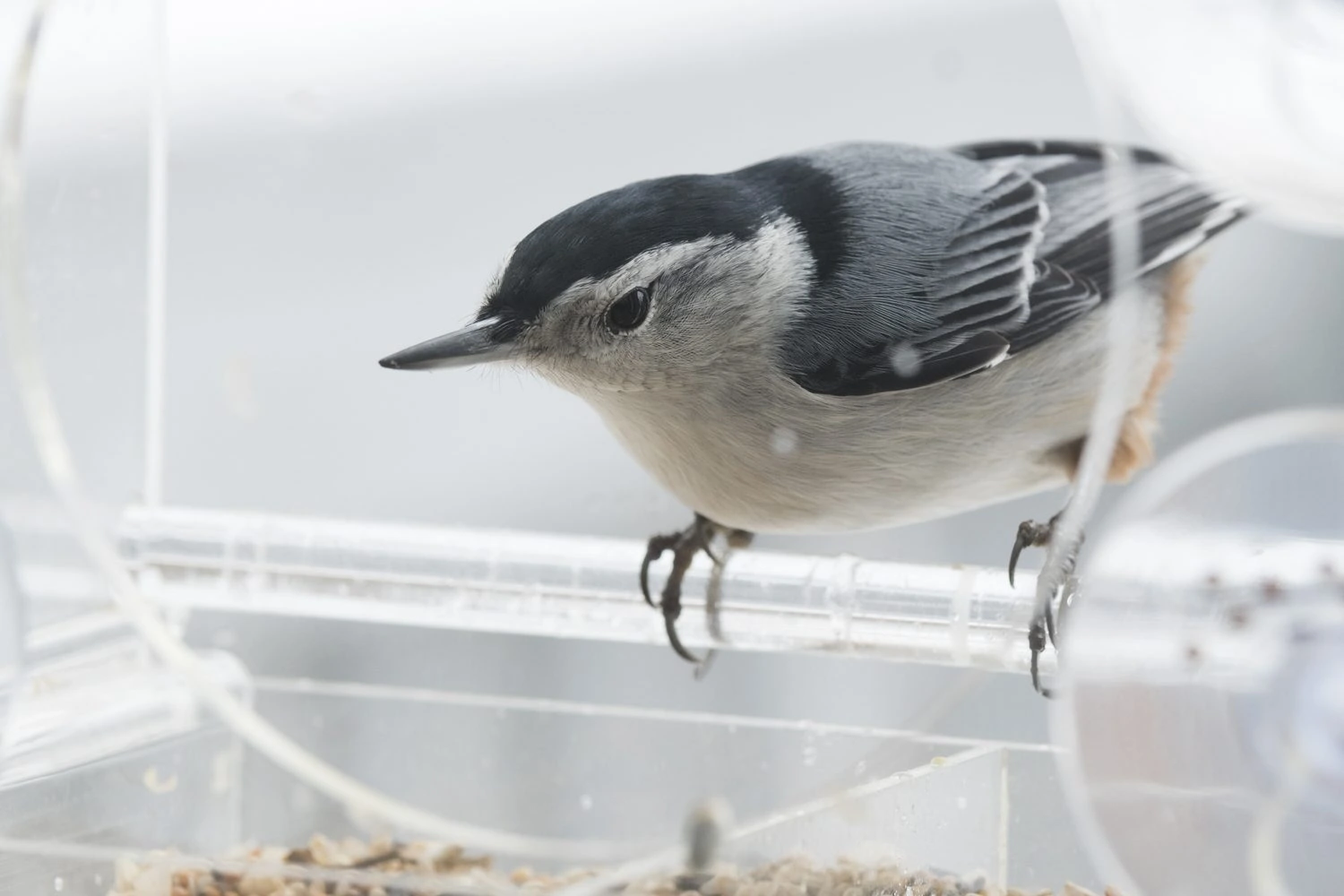
Although White-breasted Nuthatches occur in more winter checklists in Alberta, they are residents here all year and appear in 5% of summer checklists and 23% of winter checklists.
White-breasted Nuthatches are active little birds that are gray-blue on the back and white on the face and belly, with a black cap. They will often have a chestnut color on the lower belly and under the tail.
- Sitta carolinensis
- Length: 5.1-5.5 in (13-14 cm)
- Weight: 0.6-1.1 oz (18-30 g)
- Wingspan: 7.9-10.6 in (20-27 cm)
White-breasted Nuthatches live all year in the US and southern Canada.
You can find White-breasted Nuthatches in deciduous forests, woodland edges, parks, and yards with trees or at feeders. They mainly eat insects, including beetles and their larvae, caterpillars, ants, and also spiders.
White-breasted Nuthatches also eat seeds and nuts, including acorns, hawthorns, sunflower seeds, and sometimes corn crops. They jam large nuts and acorns into tree bark and then whack them with their bills to open or ‘hatch’ them to get the seed out.
White-breasted Nutcracker Call:
Attract White-breasted Nuthatches to your backyard with sunflower seeds and peanuts on tube feeders or suet feeders.
11. Yellow Warbler
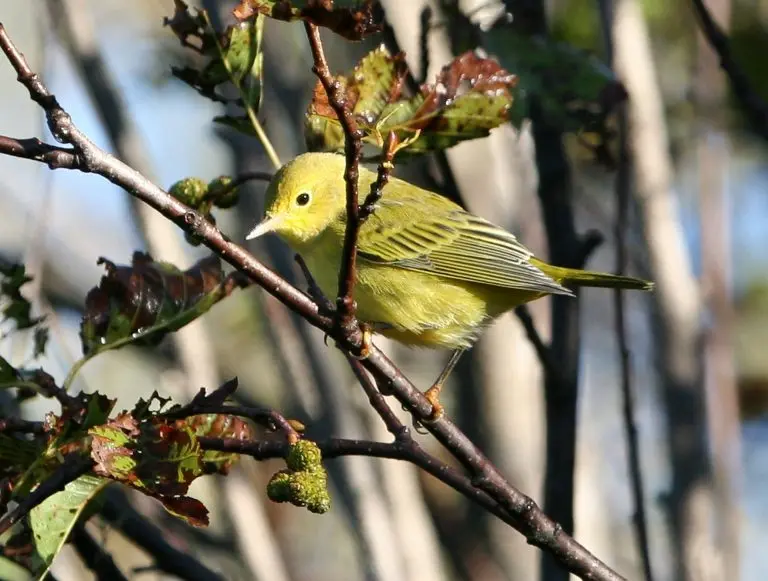
Yellow Warblers are frequently spotted in Alberta during the breeding season. They are spotted from May to September and occur in 26% of summer checklists.
Yellow Warblers are small bright yellow birds with a yellow-green back, and the males have chestnut streaks on the breast.
- Setophaga petechia
- Length: 4.7-5.1 in (12-13 cm)
- Weight: 0.3-0.4 oz (9-11 g)
- Wingspan: 6.3-7.9 in (16-20 cm)
Yellow Warblers migrate a long distance to breed in Canada and the US, except for southeastern states, before heading back into Central and South America for winter. However, they can be seen during migration in southeastern US states.
You can find Yellow Warblers along streams and wetlands in thickets and along the edges of fields foraging for insects, including caterpillars, midges, beetles, bugs, and wasps.
Yellow Warbler Song:
Attract Yellow Warblers to your backyard with suet, oranges, peanut butter, and plants with berries. Also, plant native plants that attract insects without pesticides or being too tidy! Also, try birdbaths with fountains near secluded thickets to provide protection.
There are so many yellow birds in Alberta that you will spot, especially in spring.
12. Tree Swallow
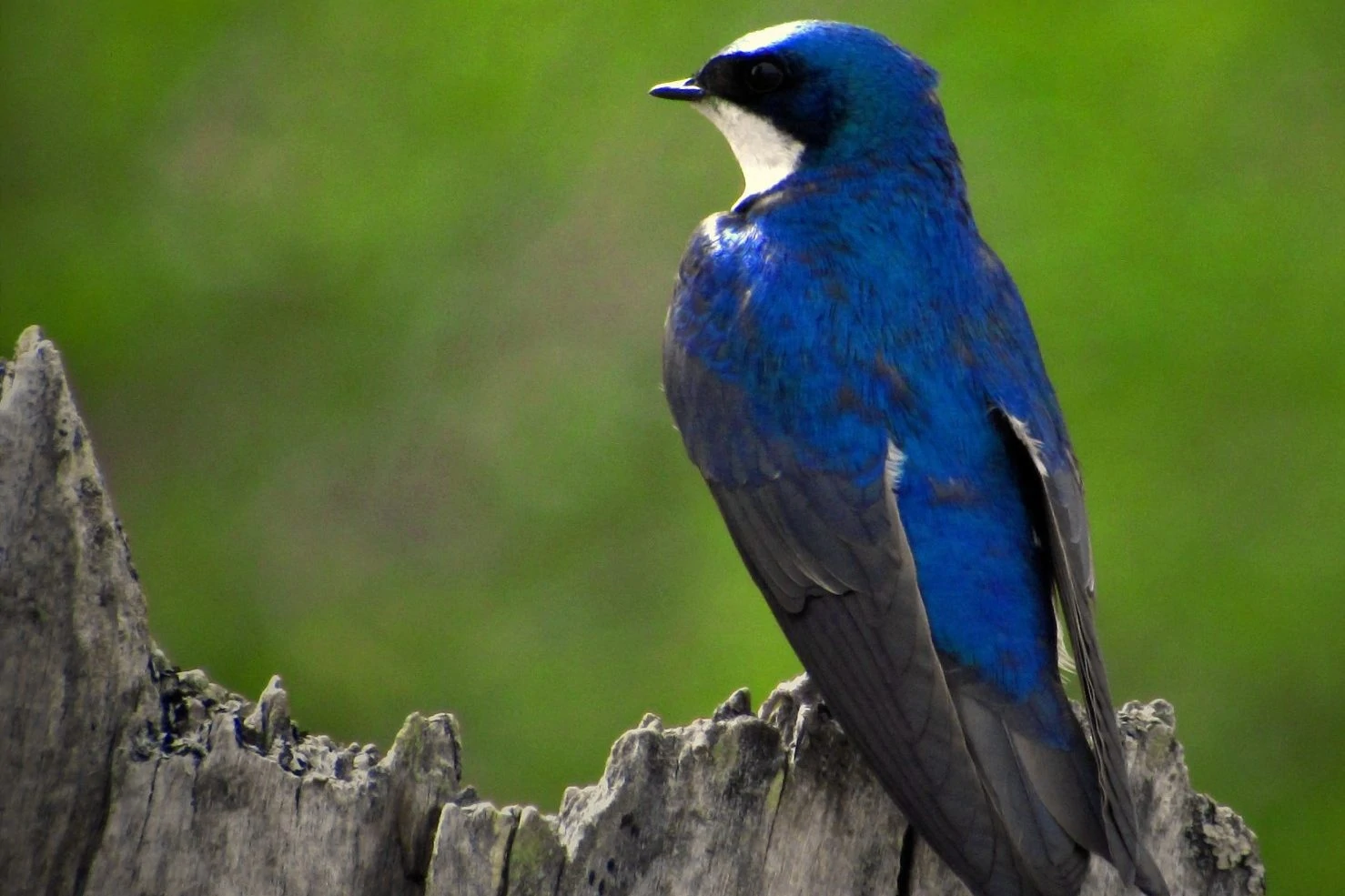
Tree Swallows spend the breeding season in Alberta and are spotted from mid-March to September. They are recorded in 32% of summer checklists.
Tree Swallows are small blue-green birds on the back and white below, with darker gray wings in the males. Females are browner in color.
- Tachycineta bicolor
- Length: 4.7-5.9 in (12-15 cm)
- Weight: 0.6-0.9 oz (16-25 g)
- Wingspan: 11.8-13.8 in (30-35 cm)
Tree Swallows breed over much of the US, Canada, and Alaska before migrating to the Gulf Coast, Florida, Mexico, and along the southern border. They can be seen during migration over southern states and can form huge flocks in the hundreds of thousands.
You can find Tree Swallows in wooded swamps, fields, marshes, and near water that provides the flying insects that they feed on.
Tree Swallow song:
Attract Tree Swallows to your backyard by placing nest boxes as they readily take to them.
13. Clay-colored Sparrow
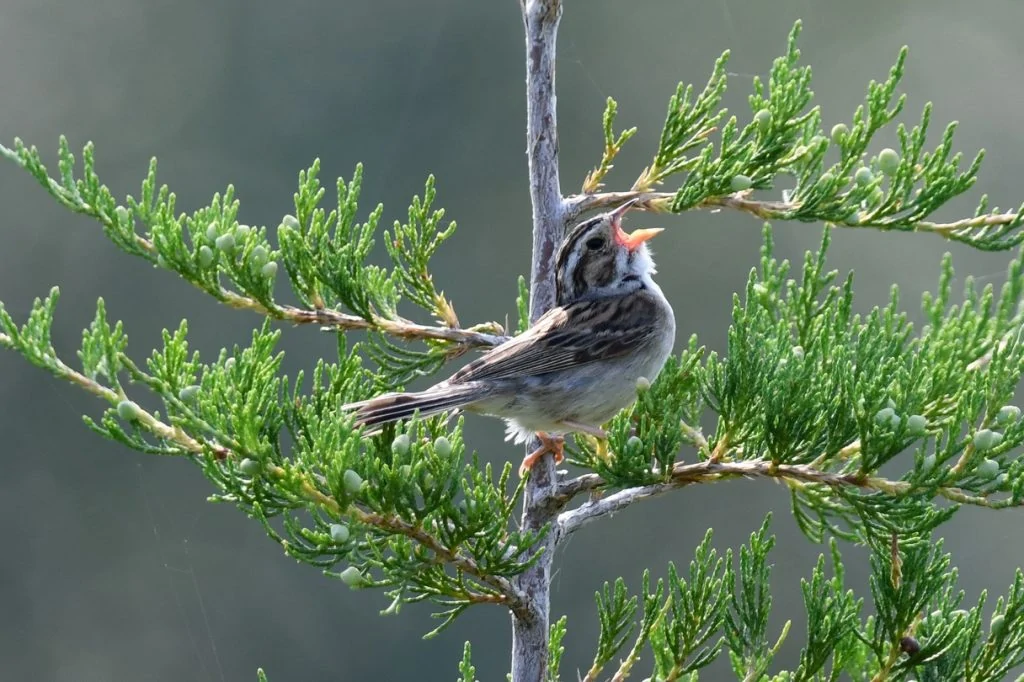
Clay-colored Sparrows spend the breeding season in Alberta and appear in 26% of summer checklists. They can be spotted from May until September.
These small, plain birds of the northern prairies and Great Plains have distinctive head markings which set them apart from other sparrows. They have a gray collar around their necks and long notched tails.
- Spizella pallida
- Length: 5.1 – 6 in (13 – 15 cm)
- Weight: 0.42 oz (12 g)
- Wingspan: 7.5 in (19 cm)
Clay-colored Sparrows are the most common sparrow you can spot in summer in the northern prairies. They breed in Canada and the northern Great Plains before migrating south to Texas and Mexico.
In summer, you can find Clay-colored Sparrows in shrubland, looking for seeds, leaf buds, or the occasional insect.
Clay-colored Sparrow sounds: Their song is a two-note buzzing sound.
14. Northern Flicker
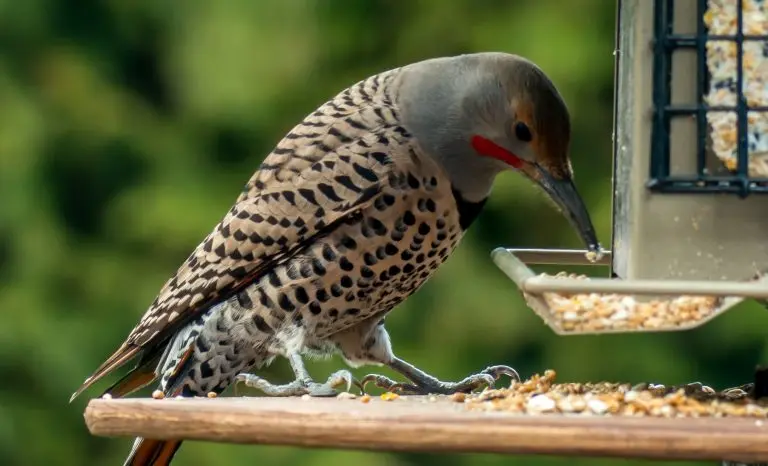
Northern Flickers spend the breeding season in Alberta, but they can also be spotted in the province all year. They are spotted in up to 22% of summer and winter checklists for the province.
Northern Flickers are large brown woodpeckers with black spots and a white patch on their rump in flight, plus a red nape of the neck in the males.
Northern Flickers have red or yellow flashes in the wings and tail depending on where they originate. Red-shafted birds live in the west, and yellow-shafted birds live in the east.
- Colaptes auratus
- Length: 11.0-12.2 in (28-31 cm)
- Weight: 3.9-5.6 oz (110-160 g)
- Wingspan: 16.5-20.1 in (42-51 cm)
Northern Flickers can be spotted across the US all year and in Canada during summer. Those that breed in Canada migrate south for the winter.
Northern Flickers mainly eat ants, beetles, fruits, and seeds, and they can often be seen on the ground digging with their curved bill.
Northern flicker Call:
Attract Northern Flickers to your backyard with suet.
15. Cedar Waxwing
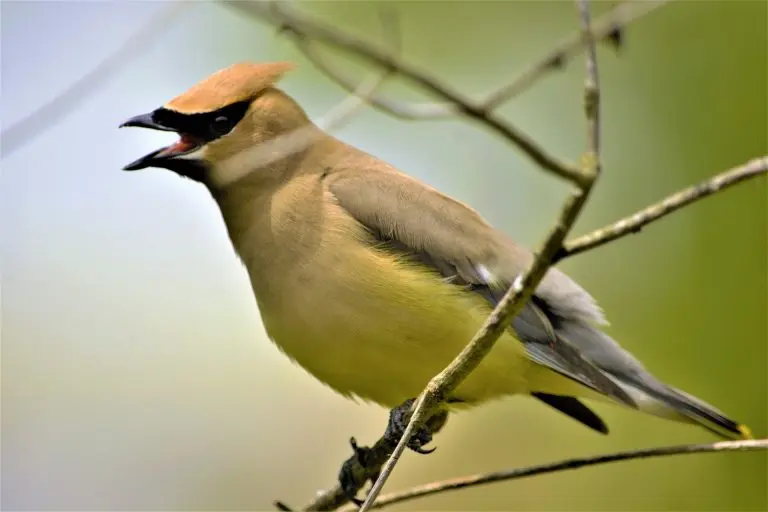
Cedar Waxwings are mainly seen in Alberta during the breeding season from May to October. They are recorded in 16% of summer checklists.
Cedar Waxwings are elegant social birds that are pale brown on the head, chest, and crest, which fades to gray on the back, wings, and tail.
Their belly is pale yellow and bright yellow towards the tail. They have a narrow black mask over their eyes and bright red on the wingtips.
- Bombycilla cedrorum
- Length: 5.5-6.7 in (14-17 cm)
- Weight: 1.1 oz (32 g)
- Wingspan: 8.7-11.8 in (22-30 cm)
Cedar Waxwings remain all year in the northern half of the US. Those that breed in Canada migrate to the southern half of the US for winter.
They make a high-pitched call and can be found in berry bushes, woodlands, and streams.
Cedar Waxwing Call:
Attract Cedar Waxwings to your backyard by planting native trees and shrubs with small fruit such as serviceberry, dogwood, juniper, winterberry, and hawthorn. You can also try fruit on platform feeders.
16. House Wren
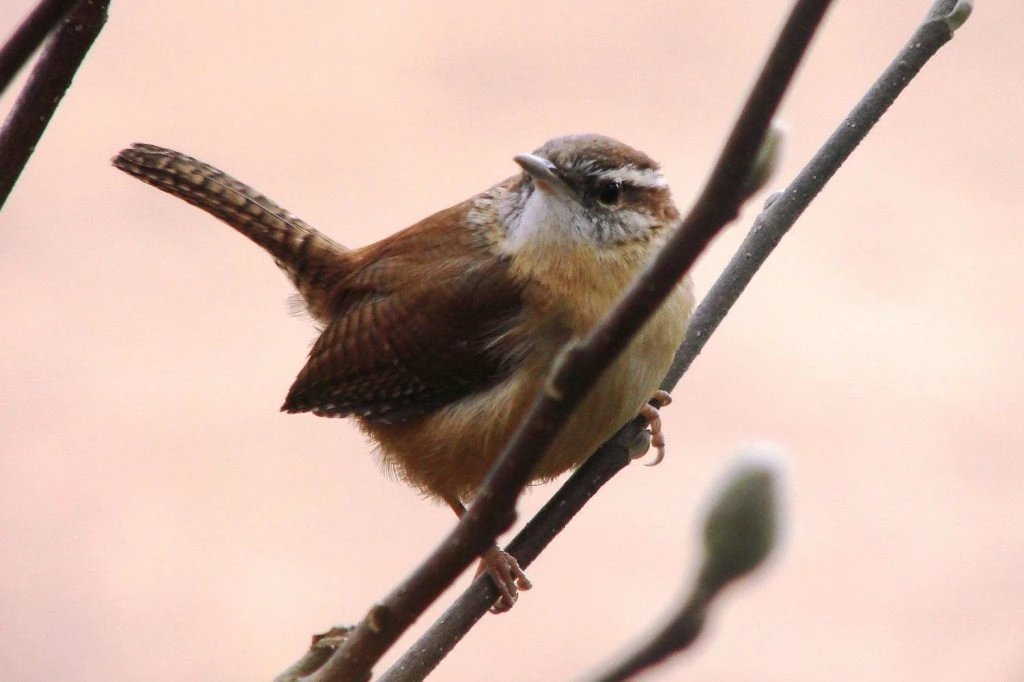
House Wrens spend the breeding season in Alberta and appear in 19% of summer checklists submitted by the bird watchers. They can be spotted here from April to October, and then they migrate south for winter.
House Wrens are small nondescript brown birds with darker barred wings and tails and a paler throat.
- Troglodytes aedon
- Length: 4.3-5.1 in (11-13 cm)
- Weight: 0.3-0.4 oz (10-12 g)
- Wingspan: 5.9 in (15 cm)
House Wrens spend their summer breeding in the US and southern Canada before migrating to southern US states and Mexico for winter.
You can find House Wrens in backyards, parks and open woods foraging for insects and spiders. They can often be found energetically hopping through tangles and low branches with their tails up, stopping to sing their cheerful song.
House Wrens are fierce for their size when it comes to getting the best nest holes. They will often harass larger birds, sometimes dragging eggs or nestlings out of a nest site they want.
House Wren Song:
Attract House Wrens to your backyard by leaving piles of brush or putting up a nest box.
Wrens are often overlooked for more flash birds, but take the time to get to know the sight and sounds of wrens in Alberta.
17. House Finch
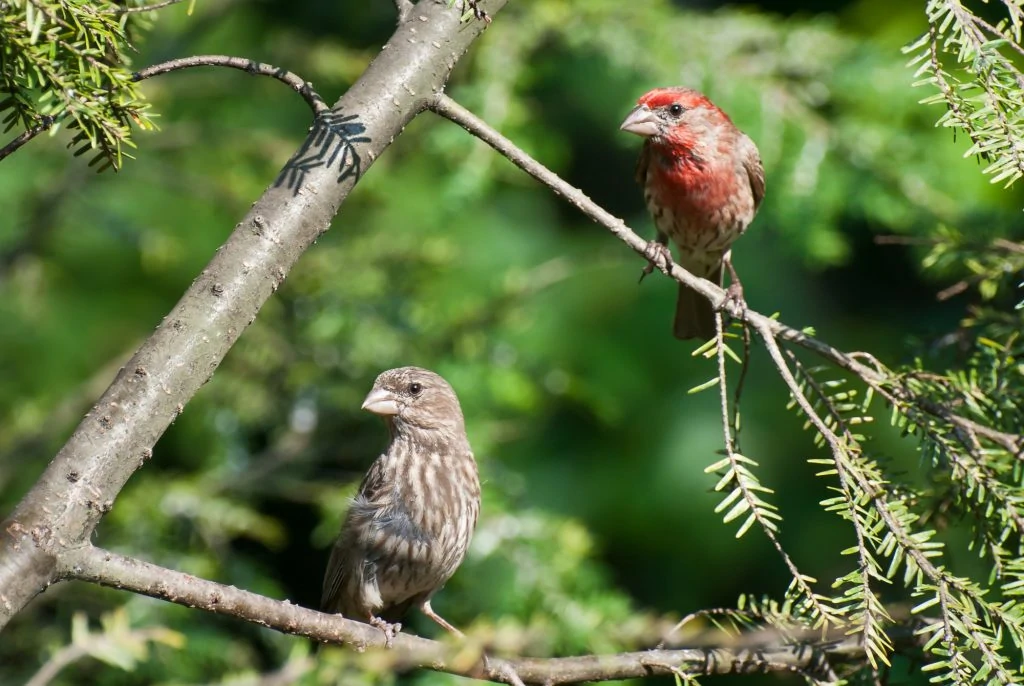
House Finches are residents of Alberta all year. They do not migrate and appear in 11% of summer checklists and 18% of winter checklists submitted by bird watchers for the province.
House Finches males have a red head and breast, and the rest of their bodies are mainly brown-streaked. Females are brown-streaked all over.
- Haemorhous mexicanus
- Length: 5.1-5.5 in (13-14 cm)
- Weight: 0.6-0.9 oz (16-27 g)
- Wingspan: 7.9-9.8 in (20-25 cm)
Originally only in western US states, House Finches were introduced to eastern US states and have done very well, even pushing out the Purple Finch.
They can be found in parks, farms, forest edges, and backyard feeders in noisy groups that are hard to miss.
House Finch Song:
House Finch Call:
Attract House Finches to backyard feeders with black oil sunflower seeds or nyjer seeds in tube feeders or platform feeders.
There are lots of other red birds in Alberta that you can spot.
18. Dark-eyed Junco
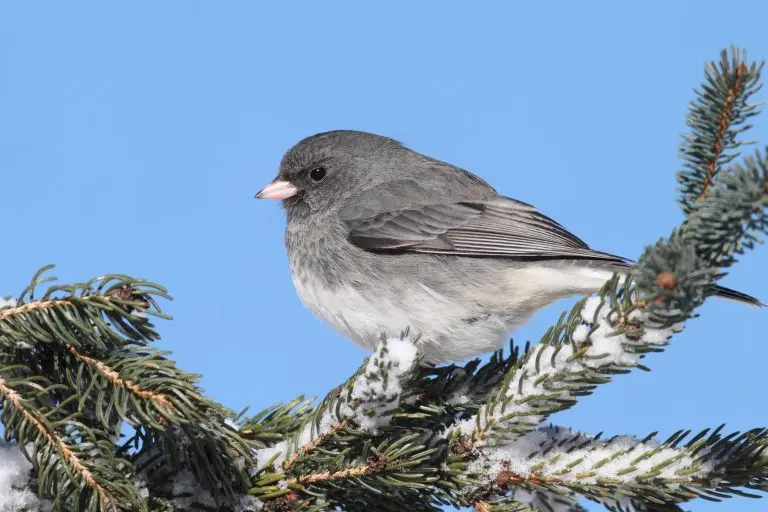
Dark-eyed Juncos can be spotted in Alberta during the breeding season, but their numbers also increase during the spring and fall migration from March to April and September to October. They are spotted in around 10% of checklists in summer and winter but up to 30% during the migration.
Dark-eyed Juncos are sparrows that are different colors depending on the state. They are generally slate-colored in the east and black, white, and brown in the west.
- Junco hyemalis
- Length: 5.5-6.3 in (14-16 cm)
- Weight: 0.6-1.1 oz (18-30 g)
- Wingspan: 7.1-9.8 in (18-25 cm)
Dark-eyed Juncos remain resident all year in northeastern and western US states and the Appalachian Mountains. Those that breed in Canada and Alaska migrate south in winter to the United States.
They can be found in open and partially wooded areas, often on the ground, and are common across the continent.
Dark-eyed Junco Song:
Attract Dark-eyed Juncos to backyard feeders with a variety of seeds such as black oil sunflower seeds, nyjer, cracked corn, millet, and peanuts. Platform feeders or scattered on the ground are best.
19. Yellow-rumped Warbler
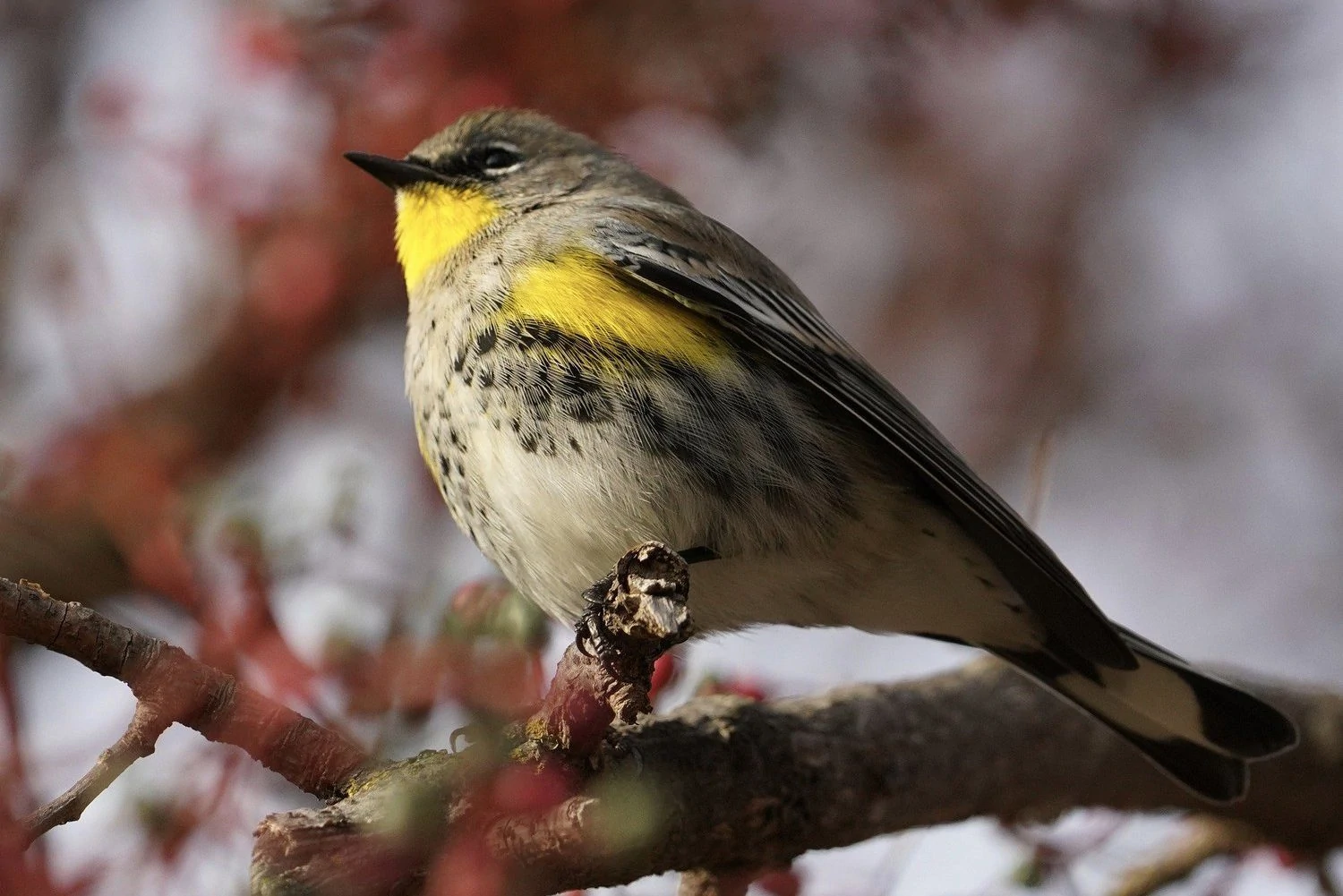
Yellow-rumped Warblers can be spotted during the breeding season in Alberta, mainly from mid-April to October. They are recorded in 19% of summer checklists submitted by bird watchers for the province.
Yellow-rumped Warblers are gray with flashes of yellow on the face, sides, and rump and white in the wings.
Females may be slightly brown, and winter birds are paler brown with bright yellow rumps and sides turning bright yellow and gray again in spring.
- Setophaga coronata
- Length: 4.7-5.5 in (12-14 cm)
- Weight: 0.4-0.5 oz (12-13 g)
- Wingspan: 7.5-9.1 in (19-23 cm)
Yellow-rumped Warblers breed predominantly in Canada and parts of the Rockies and the Appalachian mountains.
During migration, they can be seen in the Midwest before overwintering in southern and southwestern US states and the Pacific Coast and into Mexico and Central America.
You can find Yellow-rumped Warblers in coniferous forests, especially during the breeding season. During winter, they can be found in open areas with fruiting shrubs. In summer, they eat mostly insects and on migration, and in winter, they eat mostly fruit, including bayberry and wax myrtle.
Yellow-rumped Warbler Song:
Attract Yellow-rumped Warblers to your backyard with sunflower seeds, suet, raisins, and peanut butter.
20. Rock Pigeon
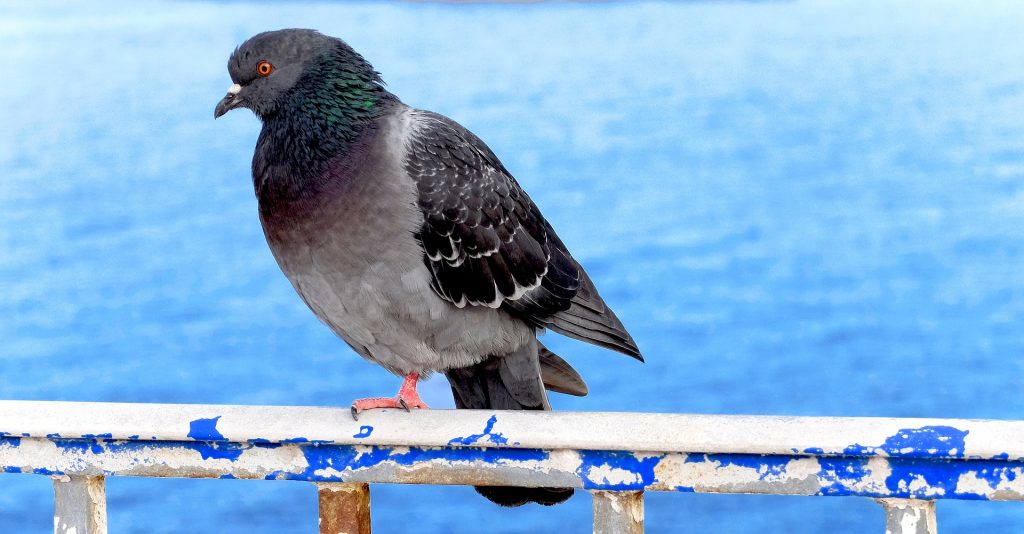
Rock Pigeons can be found all year in Alberta, mostly in the south of the province. They appear in 10% of summer checklists and 15% of winter checklists.
Rock Pigeons are blueish gray with two black bands on the wing and black on the tail tip. They have iridescent throat feathers and orange eyes.
- Columba livia
- Length: 11.8-14.2 in (30-36 cm)
- Weight: 9.3-13.4 oz (265-380 g)
- Wingspan: 19.7-26.4 in (50-67 cm)
Rock Pigeons do not migrate and can be found in all US states, southern Canada, and the Pacific Coast to Alaska.
They are common in cities and visit backyards, especially for birdseed on the ground. Some cities have ordinances against feeding pigeons as they are considered pests.
21. Hairy Woodpecker
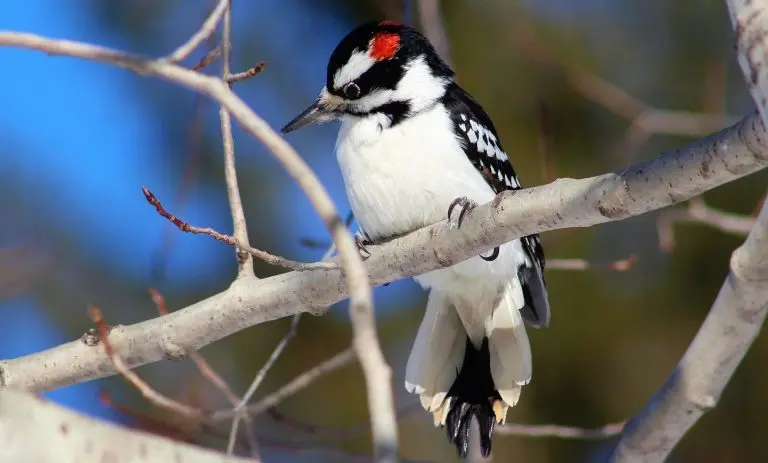
Hairy Woodpeckers are often seen from October to March, but they can be found in Alberta all year. They occur in 6% of summer checklists and 16% of winter checklists for the province.
Hairy Woodpeckers are medium-sized woodpeckers with a black and white pattern and a large white patch on their backs. The males have a flash of red towards the back of their heads.
They are visually similar to Downy Woodpeckers but larger and with longer bills. As they are often found in the same areas, it is hard to tell them apart if they are not near each other.
- Dryobates villosus
- Length: 7.1-10.2 in (18-26 cm)
- Weight: 1.4-3.4 oz (40-95 g)
- Wingspan: 13.0-16.1 in (33-41 cm)
Hairy Woodpeckers do not migrate and live in all US states and Canada, except the far north of Canada.
You can find Hairy Woodpeckers in woodlands on trunks or main branches of large trees, but they are also found in a wide variety of habitats, including woodlots, parks, and cemeteries. Hairy Woodpeckers’ diet is mostly insects.
Hairy Woodpecker Call/drumming:
Attract Hairy Woodpeckers to your backyard with suet feeders.
22. European Starling
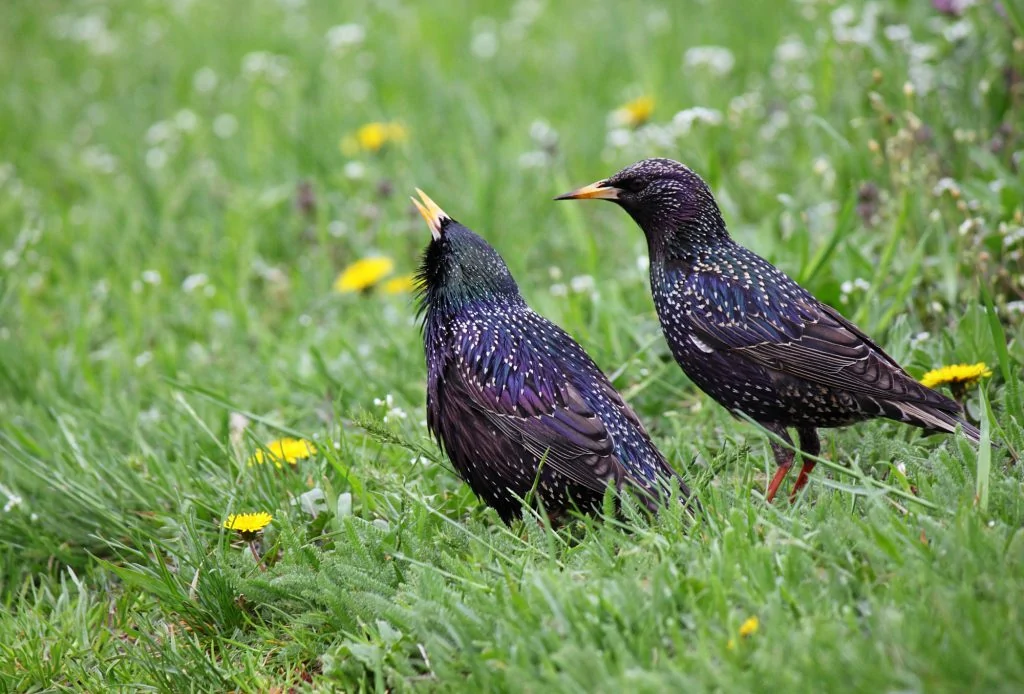
European Starlings are an introduced species in Alberta that can be seen here all year. They appear in 19% of summer checklists and 5% of winter checklists submitted by bird watchers for the province.
European Starlings are not native but are now one of the most numerous songbirds. They are stocky black birds with iridescent purple, green, and blue tones.
- Sturnus vulgaris
- Length: 7.9-9.1 in (20-23 cm)
- Weight: 2.1-3.4 oz (60-96 g)
- Wingspan: 12.2-15.8 in (31-40 cm)
European Starlings live in all of North America, except the north of Canada and Alaska.
They are considered a pest by some due to their aggressive behavior. These birds fly in large, noisy flocks and can be seen perched in groups on the top of trees or flying over fields.
European Starling Calls:
Starlings predominantly eat insects, including beetles, flies and caterpillars, earthworms, and spiders. However, they also eat fruit, including cherries, holly berries, mulberries, Virginia Creeper, sumac, blackberries, and grains and seeds.
Attract European Starlings to your backyard feeders with black oil sunflower seeds, suet, cracked corn, and peanuts.
23. Chipping Sparrow
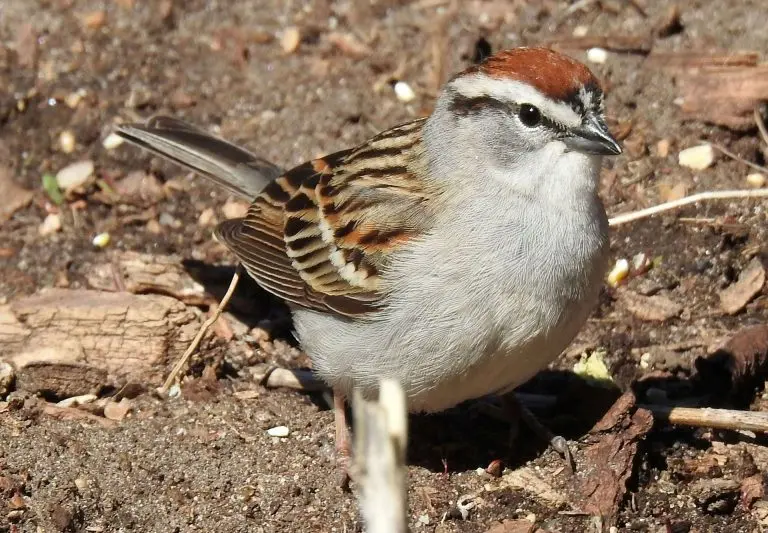
Chipping Sparrows spend the breeding season in Alberta and appear in 22% of summer checklists. They arrive in April and start to leave in mid-October.
Chipping Sparrows are slender, long-tailed birds with a grayish belly and brown and black-streaked back, with a rusty crown and black eye line. In winter, the colors are more subdued.
- Spizella passerina
- Length: 4.7-5.9 in (12-15 cm)
- Weight: 0.4-0.6 oz (11-16 g)
- Wingspan: 8.3 in (21 cm)
Chipping Sparrows spend their summer breeding in the US and Canada before flying to Mexico and Florida for winter. Some remain all year in the southern states.
You can find Chipping Sparrows in small flocks on open ground and will come to backyards for many kinds of birdseed.
Chipping Sparrow Song:
Attract Chipping Sparrows to your backyard with seeds or cracked corn on open feeders such as hoppers or platforms.
24. Savannah Sparrow
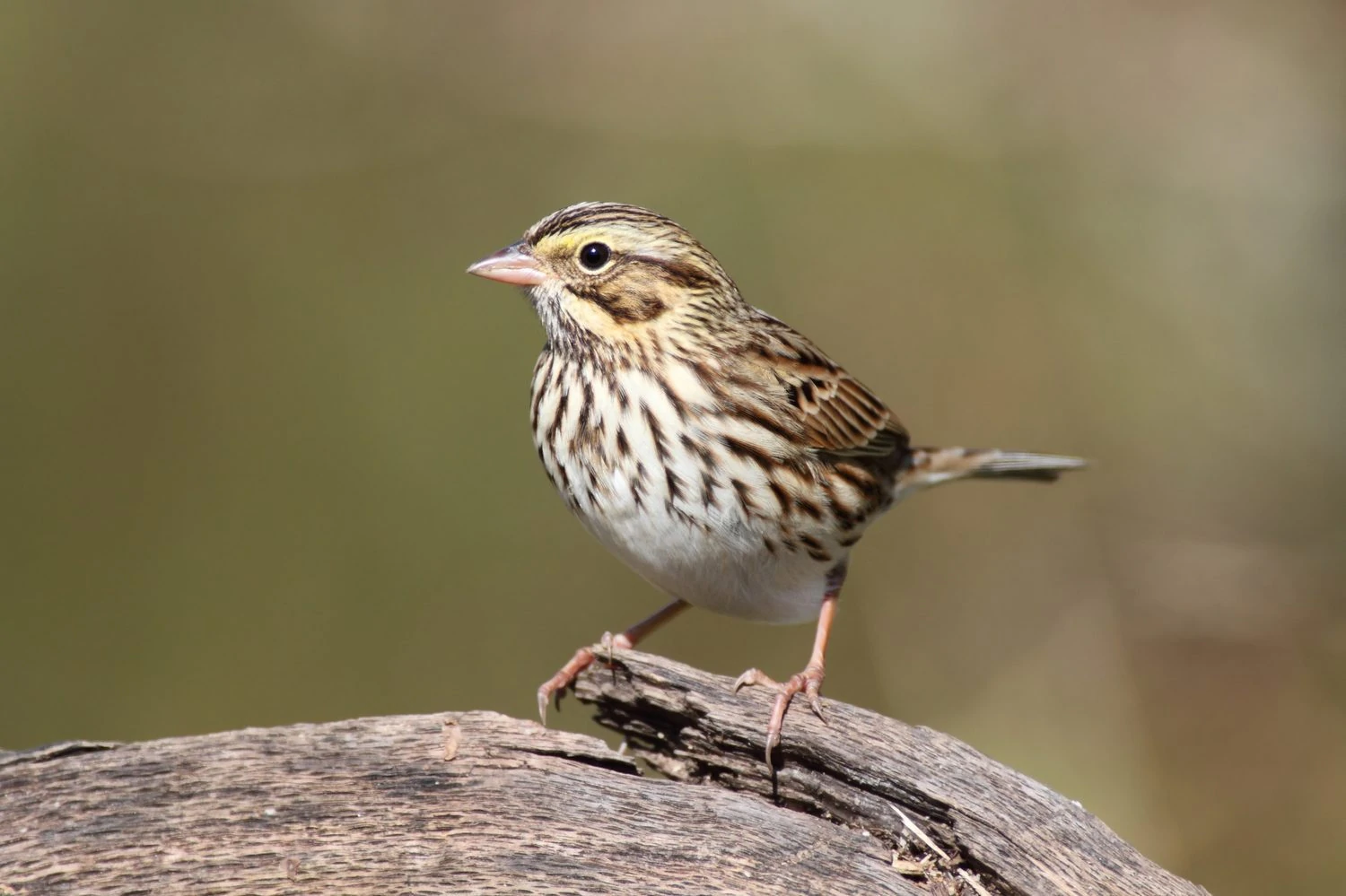
Savannah Sparrows spend the breeding season in Alberta and are most frequently spotted from April until October. They appear in 23% of summer checklists.
If you get close enough to a Savannah Sparrow, you will see this brown bird has a distinctive yellow patch by the eye. They also have short tails and a streaky brown coloring.
- Passerculus sandwichensis
- Length: 4.3-5.9 in (11-15 cm)
- Weight: 0.5-1.0 oz (15-28 g)
- Wingspan: 7.9-8.7 in (20-22 cm)
Savannah Sparrows breed in Canada and the US before migrating to southern US states and Mexico for winter.
You can find Savannah Sparrows on the ground in open areas, such as grassland, foraging for insects and spiders in the breeding season, and seeds in the winter.
Savannah Sparrow sounds: An almost rushed sounding song which is a few fast notes followed by a buzzing trill.
25. Brown-headed Cowbird
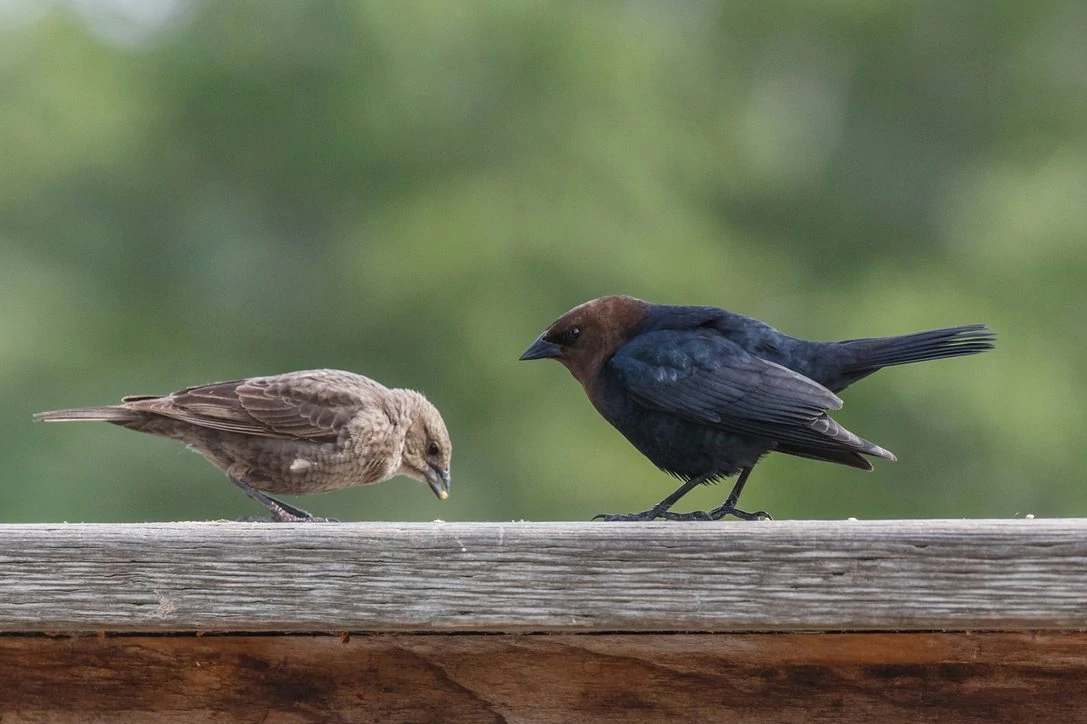
Brown-headed Cowbirds are frequently spotted in Alberta during summer and appear in 22% of checklists at this time. They spend the breeding season in the province and are spotted from April to October.
Males Brown-headed Cowbirds are larger than females, with black bodies, brown heads, and short tails. Female Brown-headed Cowbirds are brown all over with slight streaking.
- Molothrus ater
- Length: 76.3-8.7 in (19-22 cm)
- Weight: 1.3-1.8 oz (42-50 g)
- Wingspan: 14.2 in (36 cm)
Brown-headed Cowbirds remain all year in eastern US states, southern US states, and along the Pacific Coast. However, those that breed in northern and western US states and Canada migrate south for winter.
Brown-headed Cowbird Song:
They are often considered a nuisance because they are parasite birds that destroy the eggs of smaller songbirds so they can lay their eggs in the nest and have the bird foster their chicks.
26. American Goldfinch
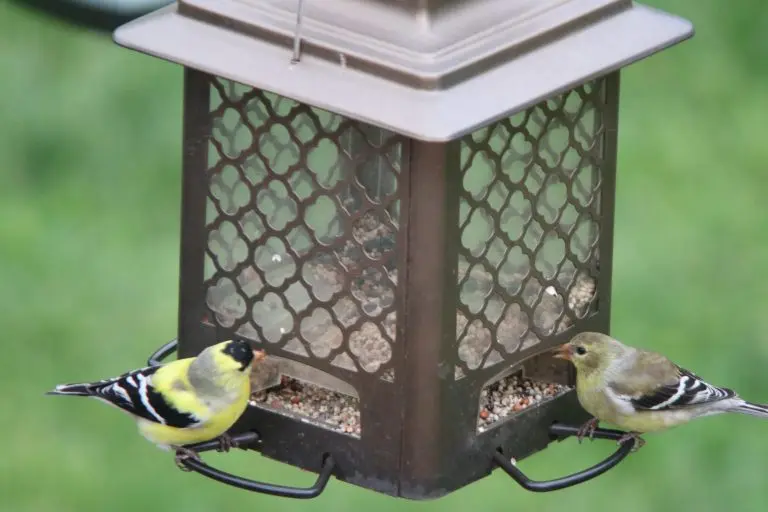
American Goldfinches are seen in the south of Alberta during the breeding season and are spotted from May to November. They are recorded in 14% of summer checklists.
American Goldfinches are popular birds with the males’ bright yellow and black coloring in spring. The females are duller brown, as are males in winter.
- Spinus tristis
- Length: 4.3-5.1 in (11-13 cm)
- Weight: 0.4-0.7 oz (11-20 g)
- Wingspan: 7.5-8.7 in (19-22 cm)
American Goldfinches can be found in most of North America and are usually resident all year. However, those that breed in Canada and the Midwest migrate to southern US States for winter.
They can be found in weedy fields and overgrown areas foraging for sunflower, thistle, and aster plants. They are also common in suburbs, parks, and backyards.
American Goldfinch Song:
Attract American Goldfinches to your backyard by planting thistles and milkweed. They will visit most bird feeders and prefer sunflower seed and nyjer seed.
There are a surprising number of finches in Alberta that you can get to know.
27. Song Sparrow
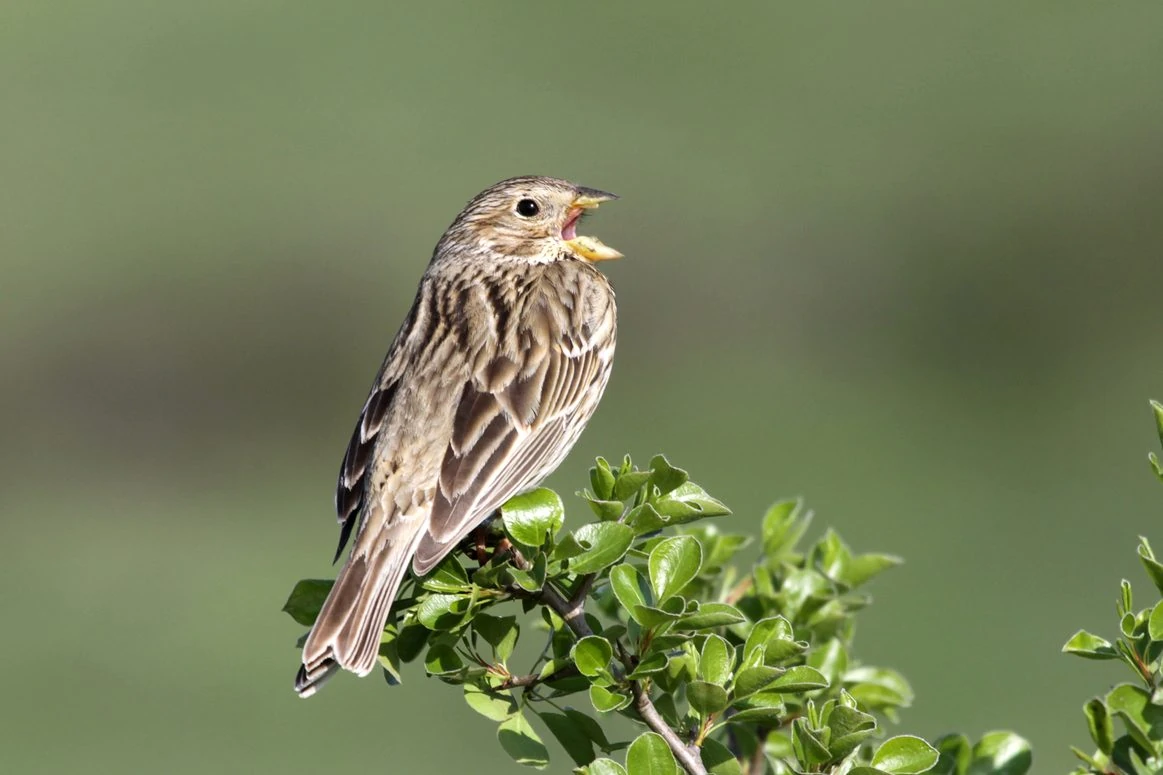
Song Sparrows are frequently spotted in Alberta during summer and are mainly seen during the breeding season, from May to August, and are recorded in 21% of summer checklists.
Song sparrows are not as remarkable looking as other backyard birds, but these predominantly brown-streaked birds use their almost constant song to attract mates in spring and summer.
- Melospiza melodia
- Length: 4.7-6.7 in (12-17 cm)
- Weight: 0.4-1.9 oz (12-53 g)
- Wingspan: 7.1-9.4 in (18-24 cm)
Song Sparrows live all year in the northern US states. Those that breed in Canada migrate to southern US states for winter.
They can be found in open, shrubby, and wet areas, often perched on a low shrub singing. They are often found at backyard feeders.
Song Sparrows eat a wide variety of insects and plants, including beetles, caterpillars, midges, spiders, and earthworms. They will also eat buckwheat, sunflower, raspberries, wild cherries, blackberries, wheat, and rice.
Song Sparrow Song:
Song Sparrow Call:
Attract Song Sparrows to your backyard feeders by putting black oil sunflower seeds, cracked corn, and nyjer on platform feeders.
28. White-throated Sparrow
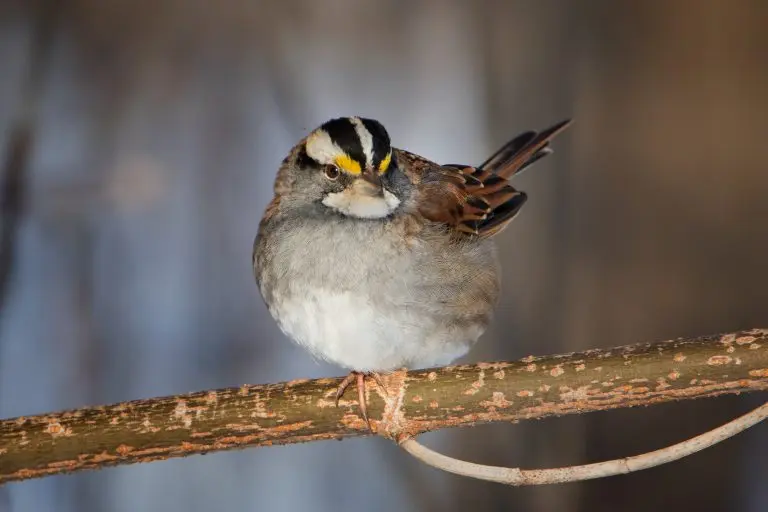
White-throated Sparrows can be found in Alberta during the breeding season, but their numbers increase during the migration. They are mainly spotted here from May to October and appear in 18% of summer checklists and up to 24% of checklists during winter.
White-throated Sparrows have a distinctive black and white striped head, bright white throat, and yellow between the eye and bill. Their backs are brown, and underneath is gray.
- Zonotrichia albicollis
- Length: 6.3-7.1 in (16-18 cm)
- Weight: 0.8-1.1 oz (22-32 g)
- Wingspan: 7.9-9.1 in (20-23 cm)
White-throated Sparrows are migratory birds, breeding mainly in Canada before heading south in winter to eastern and southern US states and the Pacific Coast.
You can find White-throated Sparrows on the ground in forests and woods and along the edges of wooded areas, often in large flocks.
White-throated Sparrows’ diet is mainly seeds of grasses and weeds and fruits such as grape, sumac, mountain ash, blueberry, blackberry, and dogwood. They will also eat many insects from the forest floor, especially in summer.
White-throated Sparrow Song:
Attract White-throated Sparrows to your backyard with millet and black oil sunflower seeds on platform feeders.
29. Pine Siskin
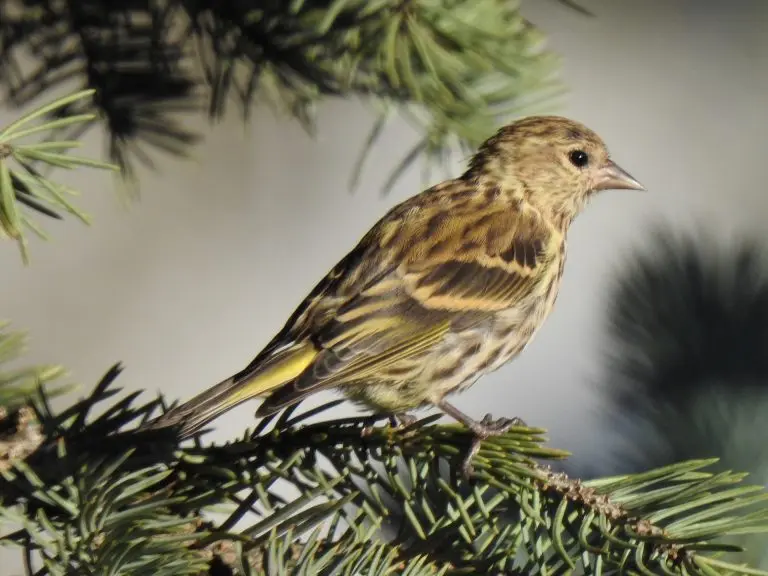
Pine Siskins spend the breeding season in Alberta, and some remain in the south of the province all year. They appear in 12% of summer checklists and 4% of winter checklists for the province.
Pine Siskins are small brown finches with yellow streaks on the wing and tail. They have a forked tail and pointed wings, with a short pointed bill.
- Spinus Pinus
- Length: 4.3-5.5 in (11-14 cm)
- Weight: 0.4-0.6 oz (12-18 g)
- Wingspan: 7.1-8.7 in (18-22 cm)
Pine Siskins remain all year in the pine forests in the western states and along the Canadian border. Some also breed in Canada before heading south for winter.
Depending on pine cone crops, they can be found over much of North America. As their name suggests, Pine Siskins predominantly eat seeds from conifers, but they also eat young buds and seeds from grasses and weeds.
Pine Siskin Song:
Attract Pine Siskins to your backyards with thistle and nyjer feeders but also black oil sunflower seeds and suet.
30. White-crowned Sparrow
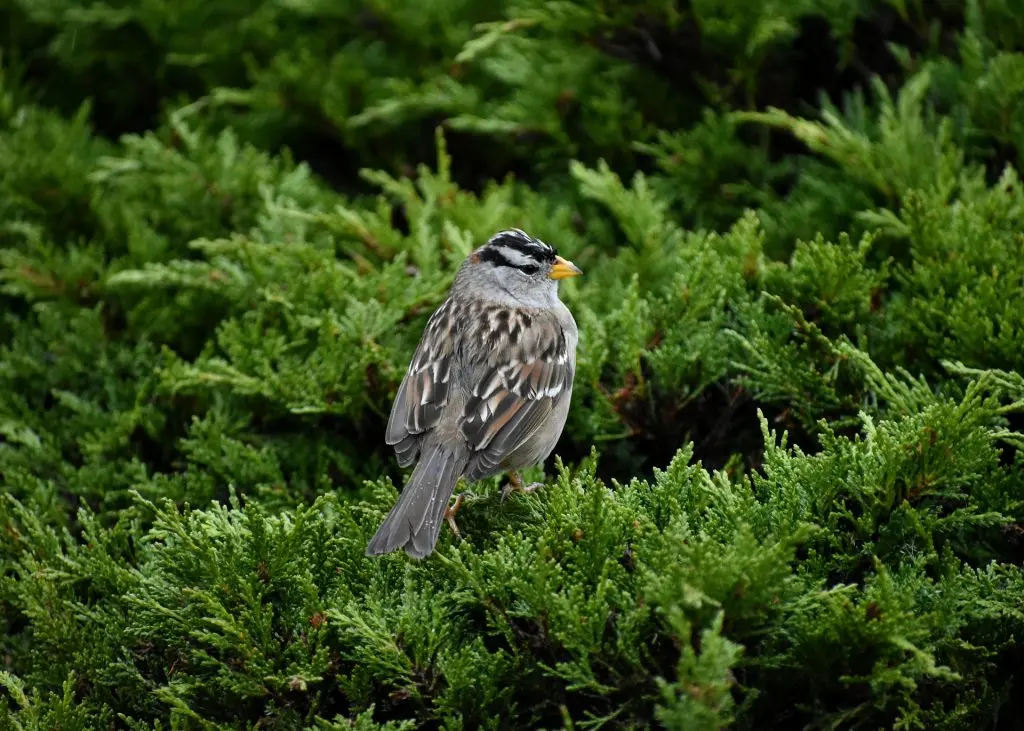
White-crowned Sparrows are mainly spotted in Alberta during the spring and fall migration in May and September, but some breed in the southwest of the province. They occur in around 10% of checklists in summer but up to 19% during the migration.
White-crowned Sparrows are large grayish sparrows with long tails, small bills, and bold black and white stripes on their heads.
- Zonotrichia leucophrys
- Length: 5.9-6.3 in (15-16 cm)
- Weight: 0.9-1.0 oz (25-28 g)
- Wingspan: 8.3-9.4 in (21-24 cm)
White-crowned Sparrows breed in Alaska and arctic Canada before heading south to the lower 48 and Mexico for winter. However, some may remain along the Pacific Coast and the mountainous west all year.
You can find White-crowned Sparrows in weedy fields, along roadsides, forest edges, and in yards foraging for seeds of weeds and grasses or fruit such as elderberries and blackberries.
White-crowned Sparrow Song:
Attract White-crowned Sparrows to your backyard with sunflower seeds, and they will also eat seeds that other birds drop at feeders.
31. Ruby-crowned Kinglet
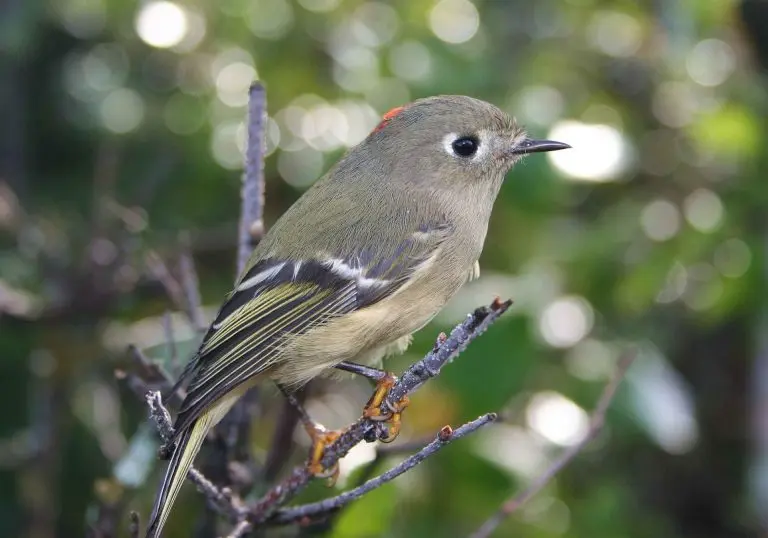
Ruby-crowned Kinglets spend the breeding season in Alberta and occur in 10% of summer checklists. They can also be spotted during migration in the southeast of the province.
Ruby-crowned Kinglets are small songbirds that are olive-green, and the males have a brilliant red crown that is usually flat, so hard to see.
- Corthylio calendula
- Length: 3.5-4.3 in (9-11 cm)
- Weight: 0.2-0.3 oz (5-10 g)
- Wingspan: 6.3-7.1 in (16-18 cm)
Ruby-crowned Kinglets breed in Canada and the mountainous west before migrating to southern and southwestern US states and Mexico for the winter.
Ruby-crowned Kinglets can be hard to spot as they are fast-moving quiet birds that flit around in the foliage of lower branches and shrubs and trees looking for spiders and insects.
Ruby-crowned Kinglet Song:
Attract Ruby-crowned Kinglets with suet or platform feeders with hulled sunflower seeds, peanut hearts, and mealworms.
Common Birds at Different Times of Year in Alberta
The birds that are attracted to backyards in Alberta change throughout the year. The lists below show the backyard birds most commonly seen at different times of the year.
Notable differences show that American Robins, Red-winged Blackbirds, American Crows, Tree Swallows, and Yellow Warblers are more common in summer and Black-capped Chickadees, Downy Woodpeckers, and Blue Jays are more common in winter.
Common birds in Alberta all year
Black-billed Magpie 51%
Black-capped Chickadee 46%
American Robin 34%
American Crow 31%
House Sparrow 25%
Downy Woodpecker 23%
Northern Flicker 22%
Red-winged Blackbird 20%
Red-breasted Nuthatch 19%
Blue Jay 18%
Summer birds Alberta
American Robin 55%
Red-winged Blackbird 46%
American Crow 40%
Black-billed Magpie 38%
Tree Swallow 33%
Black-capped Chickadee 32%
Clay-colored Sparrow 26%
Yellow Warbler 26%
Savannah Sparrow 23%
Chipping Sparrow 23%
Winter birds Alberta
Black-billed Magpie 66%
Black-capped Chickadee 63%
Downy Woodpecker 37%
House Sparrow 33%
Blue Jay 27%
Red-breasted Nuthatch 26%
White-breasted Nuthatch 23%
Northern Flicker 21%
Common Redpoll 20%
House Finch 17%
Best Bird Feeders to Attract Birds in Alberta
A variety of different bird feeders will attract the most species of birds.
- Tube Feeders can be filled with different types of birdseed, and depending on the seed, different birds will be attracted. Black oil sunflower seeds attract Goldfinches, Chickadees, Woodpeckers, Nuthatches, and Pine Siskins.
- Ground Feeders or a tray below a Tube Feeder with Black oil sunflowers tube feeders attract Cardinals, Jays, Finches, and Sparrows.
- Platform feeders with Millet or Corn attract small and medium-sized birds such as sparrows, Blackbirds, Towhees, Juncos, Doves, Grackles, and Starlings.
- Peanut feeders attract Woodpeckers, Chickadees, Nuthatches, Titmice, Jays, Juncos, Finches, and Sparrows.
- Suet Feeders are great, especially in winter, for Woodpeckers, Cardinals, Nuthatches, Kinglets, Wrens, and Chickadees.
- Hummingbird feeders attract these tiny, fascinating birds, but they also attract other birds too.
How to Attract Birds to Your Backyard in Alberta
If you would like to attract more birds to your yard in Alberta, here are some tips:
- Provide bird feeders for different types of birds to get the most species to visit your yard.
- Provide a water feature such as a birdbath fountain or stream. Ensure that the water is clean and not stagnant
- Grow native plants that will provide food and shelter. Plant trees and shrubs that provide fruit, berries, and nuts. Blackberries, wild grasses, elderberries, serviceberries, Oaks, Beeches, Cherries, sumacs, hemlocks, Purple Coneflowers, Sunflowers, Milkweed, Cardinal Flowers, Trumpet Honeysuckle, Virginia Creeper, Buttonbush, and Dogwoods.
- Let your grass grow long to provide cover and seeds.
- Leave a brush pile to provide food, protection, and nesting opportunities for birds.
- Don’t use pesticides and herbicides as these may be toxic to birds and prevent the natural foraging opportunities for insects and seeds that birds will seek in your yard.
- Set up nest boxes to attract breeding birds and ensure they are cleaned every year.
How to Identify Birds in Alberta
Here are some tips to help you identify birds:
- Size – Size is the easiest thing to notice about a bird. Birds are often measured in inches or centimeters in guide books. It’s best to take a note of the bird in terms of small, medium, or large to be able to look for it later. A small bird is about the size of a sparrow, a medium bird is about the size of a pigeon, and a large bird is the size of a goose.
- Shape – Take note of the bird’s silhouette and jot it down or draw the outline. Look at tail length, bill shape, wing shape, and overall body shape.
- Color pattern – Take a note of the main color of the head, back, belly, wings, and tail for the main color and then any secondary colors or patterns. Also, take note of any patterns such as banding, spots, or highlights.
- Behavior – Are they on the ground or high up in the trees. Are they in flocks or on their own? Can you spot what they are eating?
- Habitat – Woodlands, parks, shrubs, grasslands or meadows, shore or marsh.
- Use a bird identification app such as those created by ebird or Audubon.

